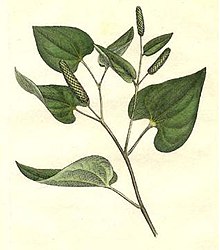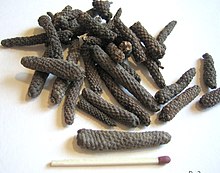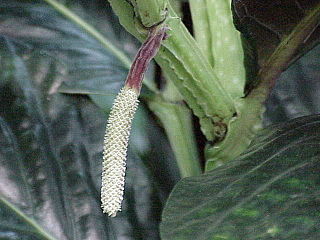
Piper, the pepper plants or pepper vines, is an economically and ecologically important genus in the family Piperaceae.

The Scoville scale is a measurement of pungency of chili peppers and other substances, recorded in Scoville heat units (SHU). It is based on the concentration of capsaicinoids, among which capsaicin is the predominant component.
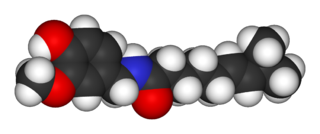
Capsaicin (8-methyl-N-vanillyl-6-nonenamide) is an active component of chili peppers, which are plants belonging to the genus Capsicum. It is a chemical irritant and neurotoxin for mammals, including humans, and produces a sensation of burning in any tissue with which it comes into contact. Capsaicin and several related amides (capsaicinoids) are produced as secondary metabolites by chili peppers, likely as deterrents against certain mammals and fungi. Pure capsaicin is a hydrophobic, colorless, highly pungent crystalline solid.

The bell pepper is the fruit of plants in the Grossum Group of the species Capsicum annuum. Cultivars of the plant produce fruits in different colors, including red, yellow, orange, green, white, chocolate, candy cane striped, and purple. Bell peppers are sometimes grouped with less pungent chili varieties as "sweet peppers". While they are botanically fruits—classified as berries—they are commonly used as a vegetable ingredient or side dish. Other varieties of the genus Capsicum are categorized as chili peppers when they are cultivated for their pungency, including some varieties of Capsicum annuum.

Chili peppers, also spelled chile or chilli, are varieties of the berry-fruit of plants from the genus Capsicum, which are members of the nightshade family Solanaceae, cultivated for their pungency. Chili peppers are widely used in many cuisines as a spice to add "heat" to dishes. Capsaicin and related compounds known as capsaicinoids are the substances that give chili peppers their intensity when ingested or applied topically. Chili peppers exhibit a range of heat and flavors. This diversity is the reason behind the availability of different types of paprika and chili powder, each offering its own taste and heat level.

Black pepper is a flowering vine in the family Piperaceae, cultivated for its fruit, which is usually dried and used as a spice and seasoning. The fruit is a drupe (stonefruit) which is about 5 mm (0.20 in) in diameter, dark red, and contains a stone which encloses a single pepper seed. Peppercorns and the ground pepper derived from them may be described simply as pepper, or more precisely as black pepper, green pepper, or white pepper.
Green pepper can refer to:

Capsicum pubescens is a plant of the genus Capsicum (pepper). The species name, pubescens, refers to the hairy leaves of this pepper. The hairiness of the leaves, along with the black seeds, make Capsicum pubescens distinguishable from other Capsicum species. Capsicum pubescens has pungent yellow, orange, red, green or brown fruits.
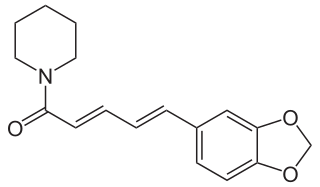
Piperine, possibly along with its isomer chavicine, is the compound responsible for the pungency of black pepper and long pepper. It has been used in some forms of traditional medicine.
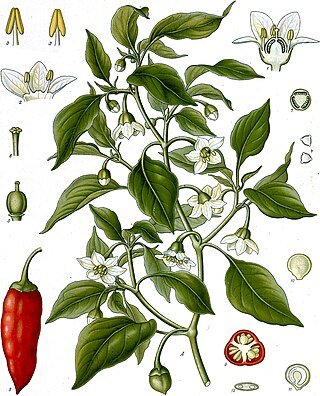
Capsicum annuum is a fruiting plant from the family Solanaceae (nightshades), within the genus Capsicum which is native to the northern regions of South America and to southwestern North America. The plant produces berries of many colors including red, green, and yellow, often with pungent taste. It also has many varieties and common names including paprika, chili pepper, jalapeño, cayenne, bell pepper, and many more with over 200 variations within the species. It is also one of the oldest cultivated crops, with domestication dating back to around 6,000 years ago in regions of Mexico. The genus Capsicum has over 30 species but Capsicum annuum is the primary species in its genus, as it has been widely cultivated for human consumption for a substantial amount of time and has spread across the world. This species has many uses in culinary applications, medicine, self defense, and can even be ornamental.
Domesticated plants of Mesoamerica, established by agricultural developments and practices over several thousand years of pre-Columbian history, include maize and capsicum. A list of Mesoamerican cultivars and staples:

Capsicum baccatum is a member of the genus Capsicum, and is one of the five domesticated chili pepper species. The fruit tends to be very pungent, and registers 30,000 to 50,000 on the Scoville heat unit scale.
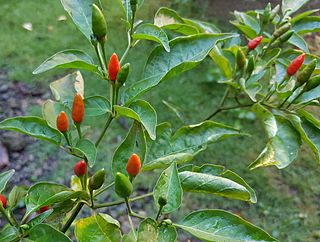
Siling labuyo is a small chili pepper cultivar that developed in the Philippines after the Columbian Exchange. It belongs to the species Capsicum frutescens and is characterized by triangular fruits that grow pointing upwards. The fruits and leaves are used in traditional Philippine cuisine. The fruit is pungent, ranking at 80,000 to 100,000 heat units in the Scoville Scale.
The following outline is provided as an overview of and topical guide to herbs and spices:

Bird's eye chili or Thai chili is a chili pepper variety from the species Capsicum annuum that is native to Mexico. Cultivated across Southeast Asia, it is used extensively in many Asian cuisines. It may be mistaken for a similar-looking chili derived from the species Capsicum frutescens, the cultivar siling labuyo. Capsicum frutescens fruits are generally smaller and characteristically point upwards.

Capsicum is a genus of flowering plants in the nightshade family Solanaceae, native to the Americas, cultivated worldwide for their edible fruit. Bell peppers, sweet peppers and some chili peppers belong to the Capsicum annuum species, making it the most cultivated species from the genus.

Paprika is a spice made from dried and ground red peppers. It is traditionally made from Capsicum annuum varietals in the Longum group, including chili peppers. Paprika can have varying levels of heat, but the chili peppers used for hot paprika tend to be milder and have thinner flesh than those used to produce chili powder. In some languages, but not English, the word paprika also refers to the plant and the fruit from which the spice is made, as well as to peppers in the Grossum group.

The cayenne pepper is a type of Capsicum annuum. It is usually a moderately hot chili pepper used to flavor dishes. Cayenne peppers are a group of tapering, 10 to 25 cm long, generally skinny, mostly red-colored peppers, often with a curved tip and somewhat rippled skin, which hang from the bush as opposed to growing upright. Most varieties are generally rated at 30,000 to 50,000 Scoville units.

The habanero is a hot variety of chili. Unripe habaneros are green, and they color as they mature. The most common color variants are orange and red, but the fruit may also be white, brown, yellow, green, or purple. Typically, a ripe habanero is 2–6 centimetres long. Habanero chilis are very hot, rated 100,000–350,000 on the Scoville scale. The habanero heat, flavor, and floral aroma make it a common ingredient in hot sauces and other spicy foods.
